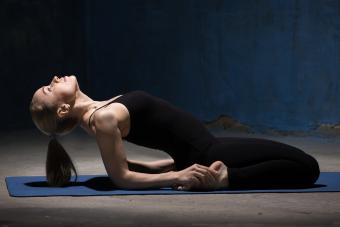
The Hero Pose, or Virasana (vee-RAH-sin-AH) is used for seated mediation and as a restful leg pose. The root of virasana is vira, the Sanskrit word for "hero" or "chief." Discover step-by-step instructions for how to perform Hero Pose as well as understanding its purpose and how to adapt it for beginners.
Step Into Hero Pose
Hero Pose can help soothe your legs, particularly after a long day on your feet. Likewise, it's often used as an alternative to Lotus Pose in meditation.
- Begin in Child's Pose.
- Move your heels to either side of your sit bones (buttocks).
- On an exhale, extend your torso up, using your hands to rotate the skin of the thighs outward.
- Sit on your heels, holding your weight evenly on both sides.
- Inhale, and rise up fully, keeping your back straight.
- Rest your palms on your thighs,
- Draw the shoulder blades down into the back, breathing deep into the belly to open the chest.
- Hold the pose for one minute or more, or five minutes if advanced.
Essentially, the goal is to sit on your knees and shins with your bottom touching your heels. Don't spread your knees and lower your bottom to the floor unless you are intermediate to advanced and free from injury, as this can create unhealthy and unsafe angles that may lead to injury or exacerbate pre-existing injury.
Contraindications
There are some health issues that may require modification of Virasana.
- If you have ankle or knee problems, seek assistance before attempting this position.
- If have very tight quadriceps, then you may need to modify the pose.
- If you have heart issues, then you may need to modify the pose. Speak to your yoga instructor.
Virasana for Beginners
Using yoga equipment helps you ease in this pose, especially if your thighs are tight.
- Place a bolster on the backs of your legs under your sit bones and sit back on the bolster.
- Or try something handy and simple, like a folded blanket or a stack of folded blankets, to ease this pose.
- Use a prop to support whichever height you are most comfortable at - for some people with extremely tight quadriceps, this may be sitting up very high and may require a brick or bolster. Use smaller objects over time as you are able to stretch more deeply.
- If you experience knee pain, stop and ask your instructor to help you modify the pose.
Deepening Virasana for Intermediate or Advanced Practitioners
To deepen the pose, you can work into Reclining Hero Pose.

- Open your feet slightly wider than your hips keeping your thighs pressed together.
- Exhale and lower your buttocks between your feet, touching the floor.
- Put your hands on the floor behind you. Lean back onto your hands.
- Over time, you will be able to progressively go lower in this pose, leaning back onto your elbows and then all the way to the floor. You can use a bolster or folded blankets for support as you work your way up to performing the full asana.
- Place your arms at your sides and open up your chest. Tuck your chin to your chest.
- Hold the pose for about one minute.
- To rise, press up to your forearms and then return to Hero Pose.
Benefits of the Hero Pose
The benefits of this asana include:
- Relief from leg swelling, especially during pregnancy
- Strengthened and limber arches of the feet, ankles, knees, and thighs
- Improved digestion
- Can help relieve menopause symptoms
Does Hero Pose Hurt Your Knees?
As long as you don't have a pre-existing knee or ankle injury and can hold the pose without pain, then Hero Pose is safe for your knees. If you do have knee or ankle injury (or are prone to them), discuss modifications with your yoga instructor and use props as needed to protect injured or vulnerable areas. If you have tender knees, you can double your yoga mat by folding it over or stacking two mats to protect knees. You can also place a rolled up yoga towel along the backs of your knees to change the angle to one that is more comfortable for you.
Many Benefits to Hero Pose
While people with knee and ankle injuries must be careful with this pose, for others with healthy knees and ankles, the pose can be quite beneficial. Never push to the point of pain in yoga, and always modify as needed to meet your own unique anatomical needs.







